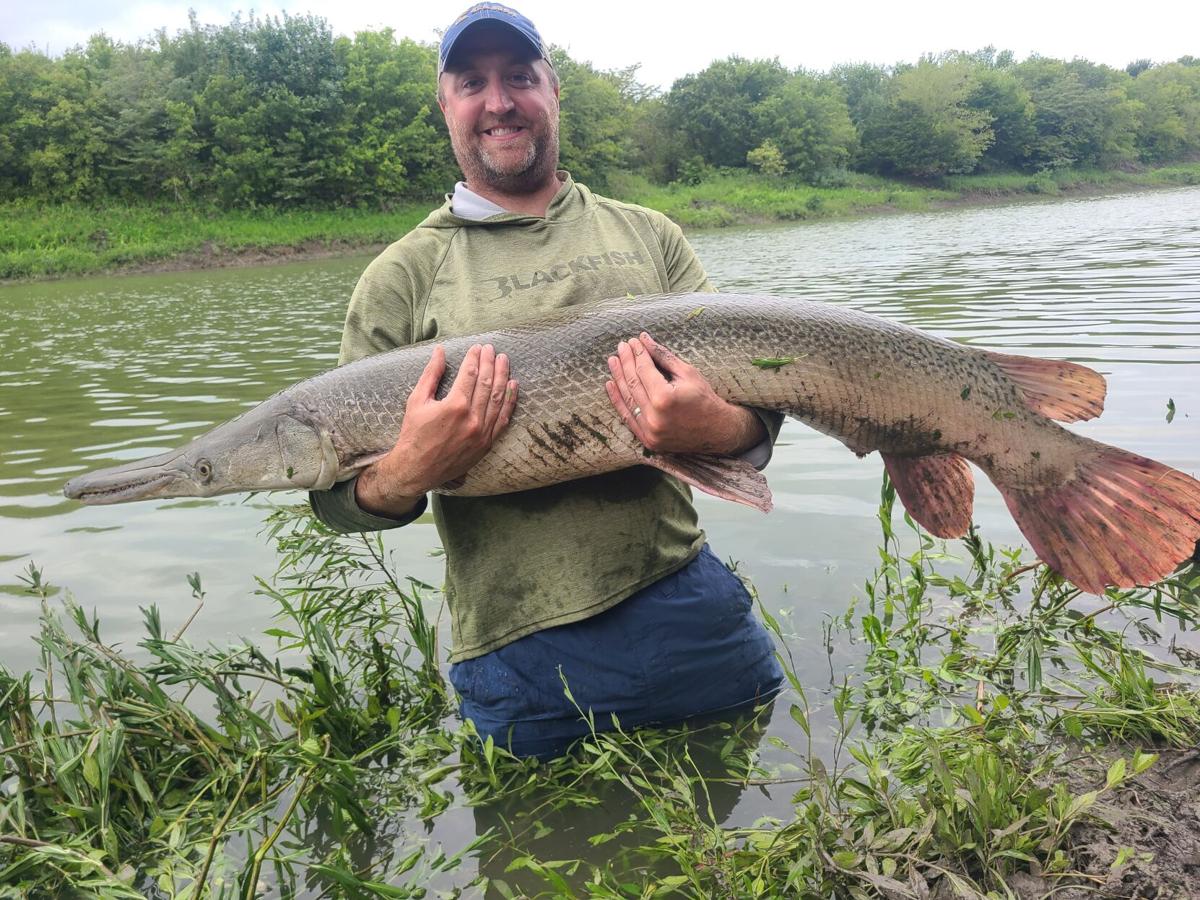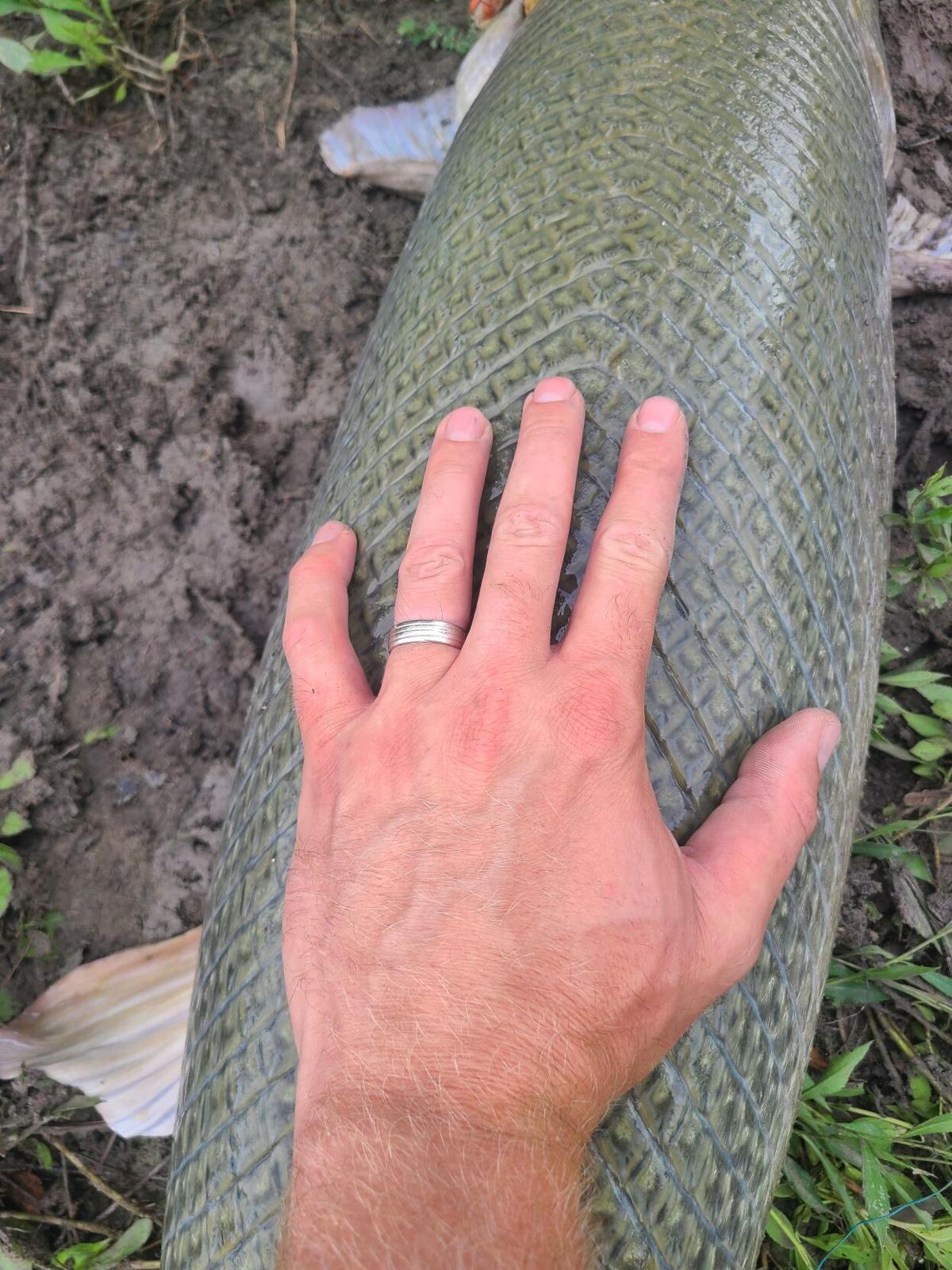By Scott Mackenthun Special to The Free Press
Aug 22, 2021

Columnist Scott Mackenthun shows the 5 1/2-foot alligator gar caught on the Trinity River in Texas.
Photos by Scott Mackenthun, special to the Free Press

Covered in tough, armor-like ganoid scales, alligator gar are incredible to behold in person.
Scott Mackenthun, special to The Free Press
A random game of chance brought about last week’s first encounter with an alligator gar.
While I get outdoors as much as possible, there still was a rut forming through the familiarity of time spent homebound during the ongoing COVID-19 pandemic. I started getting the itch to travel a couple months ago, and I dared to dream about a destination fishing trip.
Alligator gar came to my mind, and I spent idle time googling the giant fish and following Texas gar fishing guides on social media. Whether it was browser cookies or social media algorithms, I came across a lot of alligator gar content that got the angling juices flowing.
One night, I saw a post from one of the Texas gar guides that his outfit would raffle a guided fishing trip. Entries were $10 with 20 spots available.
I figured that the entry fee was a ticket to daydream, just like a lot of people buy a Powerball ticket when the jackpot runs large. If I didn’t win, and the odds were against me, it hadn’t cost me much and it permitted me to imagine a getaway trip.
A week went by and I forgot about the raffle. One night, I took my brother-in-law fishing on the Mississippi River and was flipping through my phone when I came across the raffle being conducted live. I turned it on just in time to see my number and name get called. I’d won the trip!
Carlos Guerrero of Trinity River Gar Fishing got me on the schedule for a mid-August date, and I booked my airfare. I managed to schedule some other fishing and exploring while in Dallas.
On the eve of the big trip, I waited out a torrential downpour inside the Texas Parks and Wildlife Freshwater Fisheries Center in Athens. Guerrero messaged me that the rain had hit Dallas hard, ending with just under two inches. The Trinity River rose four or five feet.
Being a river angler, I knew what it meant — the river would run high and dirty, throwing off the fish and fishing until things settled down.
The day started with a 25% chance of storms and ended in a deluge. Had my luck turned? Would my trip be cancelled or a bust? Guerrero had an idea — there was a spot he could take me, not in his boat but walking in, where we’d have a chance at some gar on a part of the river that may have missed much of the rain.
Not one to be afraid of a little hike, I was ready to give it a try and, at the very least, go down swinging.
Alligator gar have had a persecuted existence in the post-settlement United States. Long misunderstood as a nuisance or trash fish, they were wiped out of a large part of their native range by indiscriminate killing recommended by state or federal natural resource authorities, as well as habitat loss.
In the early 20th century, anglers would catch alligator gar via hook and line while another in the boat would shoot the fish with a bow or rifle when it jumped.
Today, a segment of the angling public targets the giant fish for catch-and-release fishing, and management agencies have taken steps to protect and preserve the predator, recognizing it as a valuable member of the native ecosystem.
A number of states value the alligator gar for its potential role in helping control invasive carp. Alligator gar are euryhaline, meaning they can adapt to various levels of salinity in marshes, swamps, brackish estuaries and bays in the Gulf of Mexico.
Alligator gar have ganoid scales, a specialized scale that is nearly impenetrable and tough like a covering of hard armor. These gar are living dinosaurs, an earned title since the fish is relatively unchanged in the fossil record dating back over 100 million years.
As with other primitive fishes, they have retained many ancient characteristics, like the ability to breathe atmospheric air through their swim bladder. Alligator gar is the largest species in the gar family, can grow up to 10 feet long and are estimated to live up to 100 years.
Guerrero came to north Dallas from Mexico at the age of 3. He learned English, holds a work visa for residency and has plans to pursue full citizenship.
Fishing was always in his blood. Once he became smitten with alligator gar, he didn’t want to fish for anything else.
Alligator gar anglers run in small circles, and he kept bumping into a friend that wanted to learn more. Over time, he came to trust Walter Murga, and together, the pair guides anglers through Trinity River Gar Fishing in the Dallas-Fort Worth area.
Murga came to Irving, Texas, from El Salvador at the age of 6. Like Guerrero, he learned English as a second language and plans to turned his visa into citizenship.
The sun has just risen as Guerrero and Murga met me on a nondescript road beyond the outlying southern suburbs of Dallas. It was steamy and hot, a product of the rain the evening before.
A half-mile walk took us along an isolated stretch of the Trinity River. There was just enough light to make out dark shapes just below the river’s lazily flowing, olive-drab surface — the black outlines of schools of buffalo fish.
Rebar mounted rod holders were pushed into the viscous Texas mud on the stream’s banks at openings in the treeline that gave us a good view upstream and down. Long, heavy action rods with 100-pound braided line cast huge chunks of cut up carp on small treble hooks on wire leaders, loosely equivalent to northerners using quick strike rigs for northern pike on tip-ups.
“Now we wait,” Carlos said as the last rod is cast.
Texas has no limits on fishing rods used, but to keep things from getting tangled, we launched six baits into the river at equally spaced intervals. Guerrero and Murga watched line and rod tips carefully, the mark of good live and dead bait anglers.
The baits were bumped frequently, but it’s often being played with by softshell turtles. The turtles have telltale behavioral signs, like constant pecking or swimming off short distances with the bait.
After an hour and a half, we moved to a clearing further downstream, hoping to be rid of the pesky turtles.
Throughout the morning, alligator gar are rising to the surface, rolling around or gulping air before descending into the river’s murkiness. One large individual takes away Guerrero’s and my breath.
“That was a seven-footer for sure,” Carlos said.
After seven years of guiding, he’s still in awe of these fish. The river is teeming with gar, but we can’t seem to convince any to take our bait.
Another hour passed when suddenly one of the lines shot out. We scrambled to the rod and pull line of the spinning reel arbor, hoping the fish didn’t detect any resistance and drop the bait.
Alligator gar must be given time to carry the bait off in their mouth. For four or five minutes, we gave the fish line as it started to cut upstream.
We neared the end of the spool, when Carlos announced that even though the fish hadn’t stopped running with the bait, we had no choice but to set the hook.
I reeled up the slack, felt the weight, then swung the rod tip backward while reeling in an attempt to drive the hook into the fish’s bony mouth.
The line tightened and began running out. I added a couple more hard pulls to ensure a set hook.
The fish kept moving upriver, unabated. Eventually, I stopped the fish and began gaining line, but it came close to the nearshore bank.
I worried that it will find some unseen snag. I worked to guide the fish toward deeper water and suddenly, she jumped out of the water and gnashed her teeth.
Fearful she’d thrown the hook, I was relieved to find her still attached.
The fish pushed out to the main current and the fight continued, with Guerrero and Murga reminding me to keep the rod tip down so I don’t encourage another jump.
Because alligator gar have such incredibly sharp teeth, guides don’t carry landing nets as the fish would simply tear holes through them.
Instead, everyone relies on the most Texas thing you can think of — a rope is used to “lasso” the fish around it’s hard, bony head and haul it to shore.
Guerrero worked the rope around my fishing line as we brought in the gar.
The tensest moments of the entire battle was trying to attach the rope. On three occasions, as Guerrero slid the rope over the rostrum, the tired fish found the energy to dart back into the river, pulling drag each time and making our hearts race.
We spotted the treble hook in the bony corner of the mouth and feared it would pull out. Finally, we got the 5 1/2-foot gar ashore and took a few pictures.
Despite the appearance of hanging precariously, we found the treble hook was well-seated. Because gar can breathe atmospheric air, the fish can be kept out of water far longer than other sport fish.
I took a few pictures of the incredible fish’s head and back, then Guerrero picked up the fish to hand it to me.
While Guerrero picked up the fish, the gar opened its mouth and a fold of Guerrero’s T-shirt fell inside just as the fish closed its mouth. After waiting a second, the fish opened its mouth again and the shirt fell out with several fresh holes.
You wouldn’t want your hand in that girl’s mouth!
After a couple quick pictures, the fish was released to fight another day.
Eventually the humidity broke as well as the overcast skies, and the hot Texas sun came out of hiding to warm and dry the muddy ground and usher in the conclusion of the day’s trip.
Two more bait pickups happened, but each time, the gar dropped the bait. Such is life for alligator gar anglers — you battle turtles, you hope the gar keep the bait long enough to get hooked up, and you get snubbed by many fish.
All for a chance to reel in an incredible fish in an incredible place.
Scott Mackenthun is an outdoors enthusiast who has been writing about hunting and fishing since 2005. He resides in New Prague and may be contacted at scott.mackenthun@gmail.com.
No comments:
Post a Comment